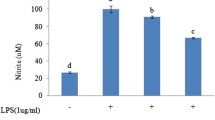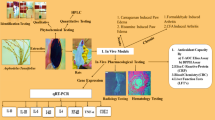Abstract
Euphorbia hirta L. has been widely used in India and Chinese society. The molecular pharmacology basis of its anti-inflammatory effect is revealed in this work. The ethanol extract of Euphorbia hirta L. (Eh) and its active component were studied in lipopolysaccharide (LPS)-activated macrophage cells (RAW 264.7) as an established inflammation model. After activation, nitric oxide (NO) production and expression of iNOS protein and iNOS mRNA were measured by using a colorimetric assay (Griess reagent), western blotting, and reverse transcription polymerase chain reaction (RT-PCR), respectively. The alteration in the content of PGE2, TNFα, and IL-6 was concurrently monitored by ELISA. In results, we found that in the concentration range without showing cytotoxicity, Eh produced a remarkable anti-inflammatory effect via its active component of β-amyrin and showed a dose-related inhibition of LPS-induced NO production. This phenomenon is in accordance with a substantial inhibition of iNOS protein. However, the expression of iNOS gene was unaffected by Eh treatments. Compared with indomethacin, Eh has much more potency and a specific action of NO inhibition but Eh works less specifically on PGE2, IL-6, and TNF-α inhibition. The extract of Euphorbia hirta L. and its component β-amyrin are able to block most of the iNOS protein functions and NO induction, and could therefore be new selective NO inhibitors with great potential in treating arthritis inflammation.






Similar content being viewed by others
References
Abramson SB (2008) Nitric oxide in inflammation and pain associated with osteoarthritis. Arthritis Res Ther 10(Suppl 2):S2
Lee MS, Tu YK, Chao CCK, Chen SC, Chen CY, Chan YS, Yeh WL, Ueng SWN (2005) Inhibition of nitric oxide can ameliorate apoptosis and modulate matrix protein gene expression in bacteria infected chondrocytes in vitro. J Orthop Res 23:440–445
Hesslinger C, Strub A, Boer R, Ulrich WR, Lehner MD, Braun C (2009) Inhibition of inducible nitric oxide synthase in respiratory diseases. Biochem Soc Trans 37:886–891
Kim YM, Lee BS, Yi KY, Paik SG (1997) Upstream NF-kappaB site is required for the maximal expression of mouse inducible nitric oxide synthase gene in interferon-gamma plus lipopolysaccharide-induced RAW 264.7 macrophages. Biochem Biophys Res Commun 236:655–660
Xie QW, Whisnant R, Nathan C (1993) Promoter of the mouse gene encoding calcium-independent nitric oxide synthase confers inducibility by interferon gamma and bacterial lipopolysaccharide: suppression of arthritis by an inhibitor of nitric oxide synthase. J Exp Med 177:1779–1784
Lanhers MC, Fleurentin J, Cabalion P, Rolland A, Dorfman P, Misslin R, Pelt JM (1990) Behavioural effects of Euphorbia hirta L.: sedative and anxiolytic properties. J Ethnopharmacol 29:189–198
Lanhers MC, Fleurentin J, Dorfman P, Mortier F, Pelt JM (1991) Analgesic, antipyretic and anti inflammatory properties of Euphorbia hirta. Planta Med 57:225–231
Youssouf MS, Kaiser P, Tahir M, Singh GD, Singh S, Sharma VK, Satti NK, Haque SE, Johri RK (2007) Anti-anaphylactic effect of Euphorbia hirta. Fitoterapia 78:535–539
Galvez J, Zarzuelo A, Crespo ME, Lorente MD, Ocete MA, Jiménez J (1993) Anti-diarrhoeic activity of Euphorbia hirta extract and isolation of an active flavanoid constituent. Planta Med 59:333–336
Hore SK, Ahuja V, Mehta G, Pardeep K, Pandey SK, Ahmad AH (2006) Effect of aqueous Euphorbia hirta leaf extract on gastrointestinal motility. Fitoterapia 77:35–38
Sudhakar M, Rao ChV, Rao PM, Raju DB, Venkateswarlu Y (2006) Antimicrobial activity of Caesalpinia pulcherrima, Euphorbia hirta and Asystasia gangeticum. Fitoterapia 77:378–380
Vijaya K, Ananthan S, Nalini R (1995) Antibacterial effect of theaflavin, polyphenon 60 (Camellia sinensis) and Euphorbia hirta on Shigella spp.—a cell culture study. J Ethnopharmacol 49:115–118
Johnson PB, Abdurahman EM, Tiam EA, Abdu-Aguye I, Hussaini IM (1999) Euphorbia hirta leaf extracts increase urine output and electrolytes in rats. J Ethnopharmacol 65:63–69
Singh GD, Kaiser P, Youssouf MS, Singh S, Khajuria A, Koul A, Bani S, Kapahi BK, Satti NK, Suri KA, Johri RK (2006) Inhibition of early and late phase allergic reactions by Euphorbia hirta L. Phytother Res 20:316–321
Gupta DR, Garg SK (1966) A chemical examination of Euphorbia hirta Linn. Bull Chem Soc Jpn 39:2524–2532
Leite DF, Echevarria-Lima J, Calixto JB, Rumjanek VM (2007) Multidrug resistance related protein (ABCC1) and its role on nitrite production by the murine macrophage cell line RAW 264.7. Biomed Pharmacother 73:665–674
Terra X, Valls J, Vitrac X, Mérrillon JM, Arola L, Ardèvol A, Bladé C, Fernandez-Larrea J, Pujadas G, Salvadó J, Blay M (2007) Grape-seed procyanidins act as antiinflammatory agents in endotoxin-stimulated RAW 264.7 macrophages by inhibiting NFkB signaling pathway. J Agric Food Chem 55:4357–4365
Chang YC, Li PC, Chen BC, Chang MS, Wang JL, Chiu WT, Lin CH (2006) Lipoteichoic acid-induced nitric oxide synthase expression in RAW 264.7 macrophages is mediated by cyclooxygenase-2, prostaglandin E2, protein kinase A, p38 MAPK, and nuclear factor-kappaB pathways. Cell Signal 18:1235–1243
Clancy RM, Aminm AR, Abramsonm SB (1998) The role of nitric oxide in inflammation and immunity. Arthritis Rheum 41:1141–1151
Kroncke KD, Fehsel K, Kolb-Bachofen V (1998) Inducible nitric oxide synthase in human diseases. Clin Exp Immunol 113:147–156
Szabo C, Thiemermann C (1995) Regulation of the expression of the inducible isoform of nitric oxide synthase. Adv Pharmacol 34:113–153
MacMicking J, Xie QW, Nathan C (1997) Nitric oxide and macrophage function. Annu Rev Immunol 15:323–350
Mitchell JA, Lucas R, Vojnovic I, Hasan K, Pepper JR, Warner TD (2006) Stronger inhibition by nonsteroid anti-inflammatory drugs of cyclooxygenase-1 in endothelial cells than platelets offers an explanation for increased risk of thrombotic events. FASEB J 20:2468–2475
Nishimoto N, Kishimoto T (2006) Interleukin 6: from bench to bedside. Nat Clin Pract Rheumatol 2:619–626
Kavanaugh A (2007) Interleukin-6 inhibition and clinical efficacy in rheumatoid arthritis treatment. Data from randomized clinical trials. Bull NYU Hosp Jt Dis 65(Suppl 1):S16–S20
Author information
Authors and Affiliations
Corresponding author
Rights and permissions
About this article
Cite this article
Shih, MF., Cheng, YD., Shen, CR. et al. A molecular pharmacology study into the anti-inflammatory actions of Euphorbia hirta L. on the LPS-induced RAW 264.7 cells through selective iNOS protein inhibition. J Nat Med 64, 330–335 (2010). https://doi.org/10.1007/s11418-010-0417-6
Received:
Accepted:
Published:
Issue Date:
DOI: https://doi.org/10.1007/s11418-010-0417-6




